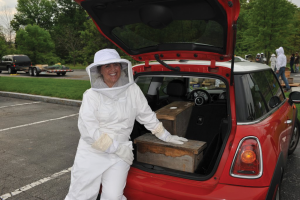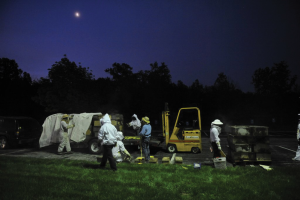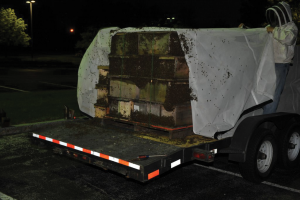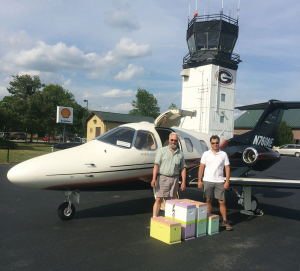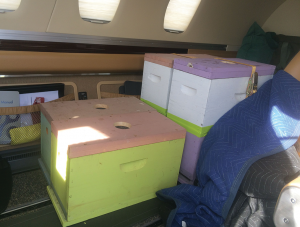By: Jennifer Berry
Moving Bees Is Stressful For The Bees, And The Beekeeper, Almost Always.
Sitting at an airport is one of my least favorite activities. Actually, that’s not true. Sitting at the airport, waiting nervously for my number to be called, being shuffled down the gang plank and stuffed into a metallic tube that’s about to shoot tens of thousands of feet into the air, and then flying on the airplane – that’s what I like the least! Now, I’m not one of those folks who have unsubstantiated fears, genetically linked or otherwise. Nope, there is a reason I hate to fly. Years ago, I experienced a flight that scared me to such a degree that I haven’t been comfortable flying since. You’re probably not in the least bit interested in what happened, but, on occasion, it helps for me to talk it through. Think of it as a sort of therapy. But don’t worry; I will spare you the details and stick to the short version.
I boarded a plane in Texas headed toward Missouri. My seat was in the front next to a nice woman who wasn’t as used to flying as I was. Across from her, was a pilot who had flown more times than I’ve inspected my hives. We didn’t really get to know each other, because as the plane taxied down the runway my attention was focused on an intense thunderstorm barreling down on us from the west.
It was early in the morning, but the sky was black. The wind jerked the trees in the distance back and forth like bobble-heads, and dust and debris tumbled in swirling streaks past the window. Lightning forked sporadically across the horizon, touching ground here and there and blinded us passengers.
The plane came to a stop at the end of the runway. I (along with the rest of the passengers) breathed a sigh of relief, thankful that the captain had come to his senses and decided to wait till the storm blew over. But NOOOOO! After only a few seconds of comforting assurance, the engines revved, the flaps went up, the brakes released and off we went, barreling toward the beast.
Right as the wheels released their grip from the tarmac, the plane was cold-cocked this way and that by the strong gusts of wind. The turbulence was the worst I had ever experienced, but we kept climbing, into the churning bowels of the storm.
The woman next to me gasped for air and squealed with each bump, obviously terrified. Fortunately for her, the pilot who sat across from me very calmly explained to her that there was nothing to worry about, that “flying was very safe,” and that “these planes were built to handle much worse turbulence.” He went on to describe what turbulence was exactly. His soothing voice not only seemed to help reduce the numbers of squeaks next door, but also began to put me at ease as well. But I couldn’t stop my teeth from rattling out of my skull. I took slow, deep breathes and relaxed the death grip I had on the armrest. That combined with the pilot’s logical calm explanations made a difference, until…
Suddenly, out the rain-streaked window, a brilliant flash of light and a loud snapping noise broke through the darkness. A single crack, a loud bang, then a cacophony of sounds exploded all at once. The plane took a nosedive. Overhead compartments flung open, and purses, baggage, and coats that were held within poured out into the aisle. But that wasn’t even the worst part. As the screams of my fellow passengers drowned out the crunch of the engines struggling to bring the plane back to horizontal, the face of the pilot across from me became white as a ghost. The man who had assured us that there was nothing to worry about, was screaming at the top of his lungs.
That was when I thought – when I accepted – that we were going to crash. And just as my heart felt like it was going to burst into a thousand tiny particles, the plane began to level off. The screech from the engines calmed, the screaming from the passengers faded into quiet murmurs, and normalcy returned.
Moments later, the captain announced over the intercom, his adrenaline obviously still pumping, “Ladies and gentleman… we’re going to be okay!” The passengers and I (and even the pilot across from me) erupted with applause. The unmistakable laughter of having just cheated death overwhelmed the fear we once had just moments ago. Sunlight peeked through the clouds and flooded the cabin. The woman next to me who had nearly broken my hand from holding it so tight hugged my neck so hard I could hardly breathe. And the pilot across from me, well, the color returned to his face along with a big ole smile.
We landed in Houston 20 minutes later. I never wanted to fly again, but I still had to make it to Kansas City. I turned right back around get on another plane, which, by the way, experienced heavy turbulence for the duration of the flight. Not a good day for me or my newly established fear of flying.
Traveling can be hard on us before, during, or after, no matter if we’re flying, driving, or taking a train. There’s the stress of planning, the packing, making arrangements for our pets, yards, and work, the travel itself, the amount of work waiting for us when we return, and what else? For me at least, no matter if I’m traveling for vacation or work, there’s always stress involved. The bright side is that my entire house isn’t being picked up and moved to a new location! Think about what it must be like for the bees when their home is relocated. All of a sudden, their entrance is blocked, there’s rumbling noises outside, a bang here, a bump there, then, whoosh, their entire home is floating through the air, swaying back and forth. There’s another loud thud, some more banging, bouncing and thumps. Next, there’s a roaring sound, and a constant shifting to the right and left, with occasional rattles and rumbles. Finally, the roaring sound ceases, then more bouncing, bright light floods into the hive and then… quiet (kinda like that flight I was on).
Each year, millions of packages and nucs are sold and redistributed across the United States (which equates to billions of bees). Bees are also moved for pollination contracts (like almonds) and honey production. And each year, these billions of bees are either shipped or hauled, eventually landing in an apiary or someone’s backyard. Packages, at one time, were the most common way to purchase bees, especially for beginners. Back in the good ole days, you could open your Sears catalog and order a package of bees. Then, once the screened box (full of bees and a queen) arrived, you’d just dump them into the hive box and let them get to work. How convenient.
Nowadays, packages are still the number one way bees are sold, but nucleus colonies are gaining in popularity. A nucleus (or nuc) consists of five frames of bees, brood, honey and pollen, and a laying queen. The main difference between a package and a nuc (and why we recommend nucs especially to beginners) is that nucs already have frames of drawn comb with brood, stored honey, and pollen. Instead of just the bees, you are purchasing a mini hive; hence nucs have a leg up on packages. The only downside to purchasing nucs is they’re almost impossible to ship, unlike packages. And moving bees, can be extremely stressful for the bees and beekeeper, which we’ll discuss here in a minute.
Another stressor is supplying nucs to beekeepers. You have to anticipate how many nucs you think you’ll be able to provide eight months prior to supplying them. We start taking orders for nuc sales in August, and are usually sold out by December. Over the years, we have been pretty good about estimating the number of nucs our colonies will be able to supply. The problem, however, arises when you take too many orders and you can’t fulfill them. For example, say we took 100 orders for nucs in August but were only able to deliver 80 in March/April: not good. By December or January, most operations are already sold out. Hence, if we (or other nuc suppliers) fail to deliver on our promise, our customers may not be beekeeping that year. Not a good feeling to let folks down, especially when they are relying on you. So, yes, I would say that’s the most nerve-racking part of raising nucs, making sure you have enough healthy bees and kick-butt queens to satisfy all your customers.
Timing is another issue too. Most folks want their bees as early as they can get them to take advantage of the nectar flow. However, Mother Nature (and the bees) are the ones in control. An extremely cold Winter or an early warm spell can wreak havoc on production. Nucs that leave our operation must have at least three to four frames of bees and brood, and one to two frames of honey and pollen. The bees and brood are usually not the problem; it’s the amount of incoming nectar. Fluctuations in weather patterns (warm to cold, dry to wet) can reduce how much nectar is being converted to honey because more nectar may be consumed than stored. You never know what the weather will do in February and March. Warmer weather encourages more brood production, which will evidently lead to bees consuming more food. In colder or wetter weather, the bees aren’t able to get out and collect the necessary food they need to support the growing population. We end up having to feed them so they won’t starve. That is why we won’t release our bees until they have plenty of food (nectar that is) to get through any future dry spells. Another issue that can cut down numbers dramatically is swarming, but that’s for another time.
After we’ve managed the bees, taken the orders, evaluated, fed, kept from swarming (or at least tried), hived the nucs, evaluated again, and talked to customers, there’s just one final item left. That’s the one that always raises my blood pressure: preparing and moving the bees to their new home. Transporting bees, whether a nuc traveling a few miles in the trunk of a car or a tractor-trailer loaded with hundreds of full size colonies for several thousand miles, is not an easy task. Precautions need to be taken for the safety of the bees and the beekeeper (plus those innocent bystanders in the interim that may encounter bees as well). There was a minor incident the first year we sold bees. A gentleman showed up with his own equipment, so we had to transfer the frames into his box. No big deal, right? Normally, it wouldn’t be, but as he was putting his ill-constructed hive into the back seat of his Mercedes Benz, the bottom board slid to the side, and out poured several hundred bees. Big deal, right? While he didn’t seem too concerned, he kept his veil on the entire ride home.
Now that’s just moving one hive. Imagine hauling several hundred nucs over several hundred miles. That’s exactly what my good friend and beekeeper extraordinaire Bob Sears does. Each year, the Eastern Missouri Beekeepers Association, situated in St. Louis, MO orders several hundred nucs from Merrimack Apiaries, located in Bunkie, LA. One of Bob’s many jobs is to drive down and haul 200 nucs back home for the club members.
It takes roughly 12 hours drive time, door to door, along with a hefty truck and trailer and nerves of steel to retrieve all the bees. No problem, but once the trailer is loaded and the bees are covered in a custom made net, there’s no dillying or dallying allowed; it’s straight home, only stopping for gas and the much needed pit stops.
Bob does try to make it somewhat of an enjoyable trip for both himself and the bees. He provides plenty of ventilation in the truck since bees can overheat quickly, especially during the day. And he doesn’t stop often; he splits the drive into two days down and back, sticking mostly to the interstate because there are more services available than on some backwoods, country roads. But more importantly, Bob rewards himself with some awesome BBQ in Jackson, MS. Once back home with the bees, the nets are removed in the dark, and members of the bee club start trickling in around 6am to collect their new pets. To date, Bob hasn’t lost a nuc. The only issue he’s encountered is queen loss. So, when club members pick up their nucs, they usually pick up a few extra queens as well.
Other things can go wrong – terribly wrong – whenever bees are being moved, so care must always be taken. Probably the best advice that I’ve received over the years from seasoned beekeepers is, “Don’t get in a hurry, and take your time!” Always make sure that the lids to the hives are firmly fastened, and the hives are ratcheted down and secured to the vehicle or trailer. Hives tipping over or breaking apart is not good for the bees. And trust me, the bees will let you know, each and every one of them, just how bad it is!
As we just described, moving bees on trucks and trailers is the usual way folks move bees from point A to point B. So, when a dear friend of mine, Jim Gross, contacted me about purchasing nucs, I didn’t think too much about it. Jim, who lives in Nantucket, wanted two nucs for himself and two for his longtime friend, James Shondel, who lived in Charleston, SC. They’ll just drop the nucs off in Charleston with James, and then Jim will continue north with his nucs. No big deal, right? Well, there’s a fun twist. The plan was, they were going to pick up and deliver their nucs in a private jet. James is a pilot and owns an Eclipse Twin Jet, which is perfect for hauling bees around (or for a family of six) since it’s fast and doesn’t need a huge airport to land. I thought: wow, now that’s cool! We should add that service to our business. Then our company slogan could read, “Jet Bees – The most rested bees since we do the flying for them”. Ok needs a little help!
We set a date for pickup and fortunately, there’s an airport close to Athens, GA, so it was convenient for both parties. When the day arrived, the weather couldn’t have been better: clear blue skies, perfect for bee travel. They called as they were leaving Charleston, which gave me an hour till touchdown. I picked them up so they could spend a few hours tooling around the bee farm. Then before it got too late, we loaded the bees into my very dirty work truck and headed back to the airport.
But the coolest part of that day was driving out onto the tarmac and loading four, double deep nucleus colonies into the belly of James’s jet. They were going to head back to Charleston and drop off two nucs for James, spend a few days, and then jet up to Nantucket and deliver Jim’s nucs. Both the guys and all the girls made it safely home.
Now, that’s the way to move bees. By the time they were loaded, re-loaded into the plane, unloaded, and then placed into their new apiary, only a few hours had passed instead of an entire day of travel. Plus, the decrease in stress level for the bees was huge considering they were not bounced on a bumpy highway from county to county. However, if it were me, I’d still be uncomfortable up there in the air, especially if turbulence hit. Not only the thoughts of flights long past tumbling around my brain, but now I’d be concerned about a nuc cracking open, releasing a few thousand pissed off bees into the tight confines of the metallic tube. Maybe I should just stick to the ground.
Be good to you and your bees.







